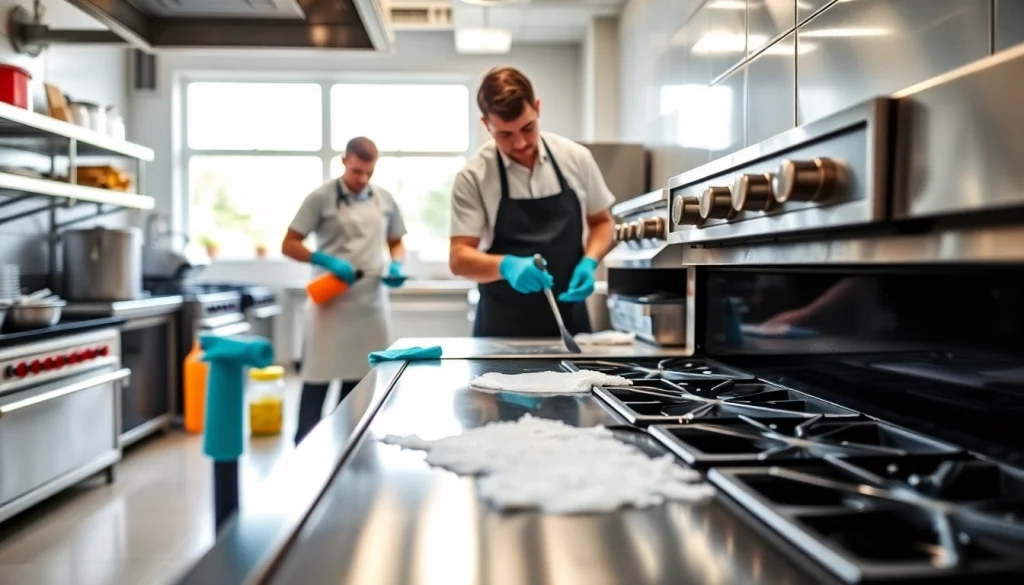Understanding Restaurant Cooking Appliance Cleaning
Restaurant cooking appliance cleaning is a critical aspect of maintaining a safe and efficient kitchen environment. The appliances used in restaurants, such as ovens, grills, fryers, and ranges, are constantly exposed to high heat, grease, and food residues, making regular cleaning essential for both functionality and hygiene. This article delves into the nuances of effective cleaning processes, best practices, the challenges associated with maintaining cleanliness, and innovative solutions tailored for restaurant kitchens.
Importance of Regular Cleaning
Regular cleaning is paramount in ensuring that cooking appliances operate at peak efficiency. Over time, grease and food particles accumulate, which can lead to decreased performance and increased energy consumption. For example, a dirty oven takes longer to cook food, directly impacting service times and customer satisfaction. Moreover, clean appliances contribute to a more pleasant working environment for staff, which can improve morale and productivity. It’s advisable to incorporate Restaurant Cooking Appliance Cleaning into your routine to foster these benefits.
Health and Safety Standards
Maintaining health and safety standards in a restaurant is non-negotiable. Regulations often dictate that kitchens must be kept clean and sanitary to prevent foodborne illnesses. Regular cleaning of appliances helps mitigate the risk of contamination. For example, grease buildup can lead to fires, posing serious threats to staff and customers. Adhering to cleaning schedules and guidelines helps ensure compliance with local health codes and can protect a restaurant from facing fines or closures due to negligence.
Consequences of Neglect
Failing to prioritize appliance cleaning can have dire repercussions. Not only does a buildup of grime affect the taste and quality of food, but it can also lead to costly repairs due to equipment failure. Grease fires are a significant risk, making neglect not just a matter of cleanliness but also of safety. Restaurants that cut corners on cleaning may face not only health inspections but also damage to their reputation if customers experience foodborne illnesses. In the long run, this negligence can result in lost revenue and even permanent closure.
Best Practices for Restaurant Cooking Appliance Cleaning
Choosing Effective Cleaning Products
When selecting cleaning products, it’s crucial to choose those that are effective yet safe for use in food preparation areas. Look for degreasers that are specifically designed for kitchen appliances, as they can break down tough grease without damaging surfaces. Eco-friendly cleaners are also a great option, promoting safety for both employees and customers. Always ensure that any products used comply with health regulations and are suitable for the specific material of the appliances being cleaned.
Step-by-Step Cleaning Processes
A structured cleaning process helps ensure thoroughness and consistency. Here’s a step-by-step approach to cleaning common restaurant cooking appliances:
- Preparation: Turn off and unplug appliances, allowing them to cool adequately before beginning the cleaning process.
- Initial Wipe Down: Use a dry cloth to remove loose crumbs and debris.
- Apply Cleaner: Spray the appropriate cleaner liberally on surfaces and let it sit for the recommended time to break down grease and stains.
- Scrubbing: Utilize scrub brushes or pads to remove tough residues, focusing on areas with a heavy buildup.
- Rinse: Wipe down surfaces with water to remove any cleaner residue. This step is especially crucial for surfaces that come into direct contact with food.
- Dry: Use a clean cloth or towel to dry surfaces thoroughly, preventing any water spots or potential corrosion.
- Final Inspection: Assess the cleanliness of the appliance and ensure everything is reassembled correctly before plugging it back in.
Frequency of Appliance Maintenance
The frequency of appliance cleaning depends on usage. High-traffic establishments may require daily cleanings, while less busy restaurants might manage with weekly deep cleans. However, regular checks should be integrated into daily routines to address minor spills or grime before they become larger issues. Ultimately, having a cleaning schedule is essential for efficiency; this ensures that all appliances receive the attention they need to operate safely and effectively.
Common Challenges in Restaurant Cooking Appliance Cleaning
Tackling Stubborn Grease and Stains
Confronting stubborn grease and stains is one of the most significant challenges faced in restaurant kitchens. Many restaurants deal with a considerable amount of fried foods, which only compounds the problem. To effectively tackle this challenge, using specialized cleaning tools like steam cleaners or high-pressure washers can be beneficial. Additionally, a trained staff that understands how to properly employ these tools increases the chances of overcoming these tough spots more effectively.
Managing Employee Training and Compliance
Even with effective cleaning products and methods, cleanliness hinges on employee compliance. Establishing a cleaning protocol and providing thorough training is essential. Regular training sessions can help ensure that all staff members understand the importance of cleanliness, feel competent in using cleaning products effectively, and adhere to proper cleaning schedules. Creating a culture of cleanliness can significantly impact the overall health of the kitchen environment.
Time Management for Cleaning Routines
Time constraints often inhibit staff from dedicating adequate attention to appliance cleaning. Balancing cleaning routines alongside food preparation and service is a common challenge. To mitigate this, integration of cleaning processes into workflows can be beneficial. For instance, designating specific cleaning tasks to be completed during less busy periods can help ensure that it’s consistently done without impacting service. Furthermore, using timers or reminders can prompt staff to stay on track.
Innovative Solutions for Efficient Restaurant Cooking Appliance Cleaning
Utilizing Technology and Tools
The restaurant industry has embraced technology to streamline cleaning processes. Automated cleaning systems, such as robotic scrubbers or dishwashers with self-cleaning capabilities, can reduce the manual burden on staff and improve effectiveness. Additionally, utilizing apps that remind staff of cleaning schedules or offer checklists can help maintain compliance and accountability. Implementing such technology not only saves time but also promotes a standardized approach to cleanliness.
Implementing Scheduled Maintenance Plans
Having a scheduled maintenance plan is an effective way to ensure that appliance cleaning does not fall by the wayside. Establishing a calendar that outlines specific cleaning tasks for different times—daily, weekly, monthly, and yearly—can help streamline operations. This approach allows staff to plan their duties accordingly, minimizing disruptions during peak hours. Scheduled maintenance can also budget for professional deep cleaning services as needed, ensuring appliances remain in top condition.
Leveraging Professional Cleaning Services
For restaurants that find it challenging to maintain cleanliness internally, leveraging professional cleaning services can prove to be an invaluable investment. These services often have access to specialized tools and cleaning products that may not be feasible for restaurant staff to handle. Moreover, professional cleaners bring expertise that can ensure appliances are cleaned correctly and safely. Partnering with these professionals can result in prolonged equipment life and a consistently clean kitchen environment.
Evaluating the Effectiveness of Restaurant Cooking Appliance Cleaning
Key Performance Indicators to Track
To assess the effectiveness of cleaning efforts, it’s crucial to develop key performance indicators (KPIs). Some useful KPIs include:
- Frequency of cleaning tasks completed on schedule
- Reduction in equipment-related issues or failures
- Employee compliance rates with cleaning protocols
- Customer satisfaction scores in relation to cleanliness
These metrics allow restaurant management to gauge the effectiveness of their cleaning routines and adjust practices as necessary.
Feedback Loops for Continuous Improvement
Creating a feedback loop where staff can share their experiences and suggestions related to cleaning processes is essential. Regular meetings can provide a platform for discussing what works well and what doesn’t. Such insights can lead to improvements and innovations in cleaning practices. Recognizing and addressing any issues promptly will foster a culture of continuous improvement and keep cleanliness at the forefront of restaurant operations.
Adapting Strategies Based on Results
Finally, it’s essential to adapt cleaning strategies based on the results gathered from KPIs and employee feedback. If certain cleaning methods are not yielding the desired results, be open to trying different products, techniques, or schedules. A flexible approach helps ensure that cleaning processes evolve in response to changing needs and challenges within the restaurant, enhancing both compliance and effectiveness over time.


